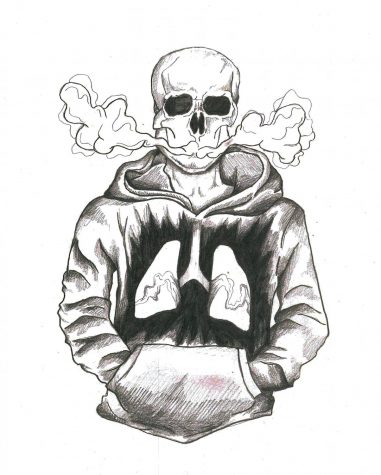Vaping outbreak sweeps the nation
Deaths, injuries, bans, with all this commotion vaping has been a hot up and growing topic in recent months
Photo Credit: Daniel Antonson
Vaping has been an ongoing trend for shortly over a decade now. And in that decade, the number of deaths and illnesses have been seldom. But in the last few months alone, there have been at least 1,479 confirmed injuries, and 33 deaths caused due to vaping. Now, talk of bans are arising, with controversy at the same pace. Illnesses, deaths, restrictions: what’s up with all this controversy?
HISTORY OF INJURY
Well, let’s start at the beginning. As early as April 2019, Illinois and Wisconsin had 53 patients who showed signs of illness due to vaping. A third of them were hospitalized. Skepticism arose, and became even more justified when in August when the first death was reported in Illinois. At the same time, nearly 200 cases of this odd sickness were being investigated in almost half the states. It wasn’t long until more deaths followed suit in at least 11 different states.
Now as of October 15th, the CDC has reported 1,479 lung injury cases from 49 states, the U.S. Virgin Islands, and the District of Columbia. 33 deaths have also been reported in 24 states. 79 percent of the patients are 35 or younger, 15 percent of which are under 18 years old. 70 percent of the patients are also male. Every single patient has a history of e-cigarette product use, or vaping.
POSSIBLE CONNECTION TO THC
These investigations have also found that these illnesses could be linked to THC. Around 78 percent of the patients who had information on what was in their e-cigarettes reported using THC-infused products. THC (Tetrahydrocannabinol) is a stimulant that causes the brain to release dopamine, which creates a sense of euphoria, or a high. It’s also the chemical in marijuana that induces the high from smoking weed. THC has been infused into many vape products, but the side effects are starting to take their toll.
The main problem with the THC in these vape products is the fact that they’re mostly obtained illicitly. These products are usually obtained from informal sources. This means they’re not regulated and have a high chance of containing unknown chemicals other than THC.
“I vaped THC. I came to class, and I was fine for about the first ten minutes. Then all of a sudden I started to black out, and I started to get sick,” an anonymous freshman at Skyline said. “I just wanted to try it… I won’t do it again. I didn’t like passing out, and I don’t want to go through that again.”
VITAMIN E IMPACT
On top of THC, vitamin E acetate is also a suspect in the sudden lung illnesses. Companies have claimed using vitamin E acetate as a “thickening agent.” While vitamin E is not known to be hazardous, that only applies to when it’s consumed using oils or vitamin supplements. However, it’s possible that it could become hazardous when inhaled due to its oil-like properties, which could cause damage to the respiratory system.
While these chemicals seem to be a likely factor in the sudden outbreak, the CDC reports that the specific chemical exposures have not yet been identified. Nor has one single substance, brand, or product been directly linked to the outbreak. Some of the outbreak patients also claimed to have only vaped nicotine, but that could be due to the patient’s hesitance to admit using THC or marijuana products.
Overall, it appears that this pandemic isn’t related to one specific product, but vaping as a whole. A large majority of interviewed patients reported using informal products, suggesting this could also be a contributing factor in the outbreak.
POTENTIAL BANS ON SALES
Amidst all this chaos of the outbreak, the US government has started to take action. The largest action taken thus far is the Trump administration’s plan is to work with the FDA to ban all flavored e-cigarette vaping products. However, despite the fact that the illnesses and deaths continue to rise, the Trump administration’s reason for the planned ban is due to the rising teen vaping problem, another issue amongst the vaping industry. The administration proposed the ban on Sept. 11th of this year, and they believe wiping the market of flavored e-cigarettes will reduce the ever-growing youth vaping epidemic.
Their reasoning is upheld by the 2019 National Youth Tobacco Survey, where the vast majority of students who admitted to using e-cigarette products said they vaped fruity, mint, or menthol flavors. Over a month later, no action has yet to be taken concerning the ban, but it’s possible that the plan is still being developed and will go into effect in the near future.
Many corporations, and even states have also taken action since the outbreak and proposed bans. On October 17th, JUUL Labs announced they will no longer sell fruity vape flavors, or “pods”. JUUL has been the face of e-cigarette use for quite some time now, and have been considered the “name brand” vape product to most. This action is a result of the widespread teenage vaping problem. JUUL will continue to sell minty, menthol, and tobacco flavors as the company believes it will continue to help adult smokers move away from cigarettes.
CDC RECOMMENDATIONS
Overall, this vaping health crisis still has plenty to be discovered. As of now the CDC strongly urges people to refrain from using e-cigarette products, especially those containing THC and illicitly obtained substances, at least until this outbreak has more breakthroughs and findings. They also recommend to not resort to smoking cigarettes instead. In general, it is wise to always refrain from using e-cigarette, tobacco, or any other substance not used to benefit your health.


Born December 22, 2001
Snowboarder, pianist (kinda), aspiring mechanical engineer
Berserker Class








